As we enter the warmer months, many of us will find ourselves wandering through nature more often, perhaps while camping or taking an evening walk through wild areas. We might encounter birds of prey during these times, and many of us will ask ‘Which one is that?’. Here we look at a selection of the 15 birds of prey in the UK, covering every group of predatory bird aside from vultures.
Red Kite (Milvus milvus)
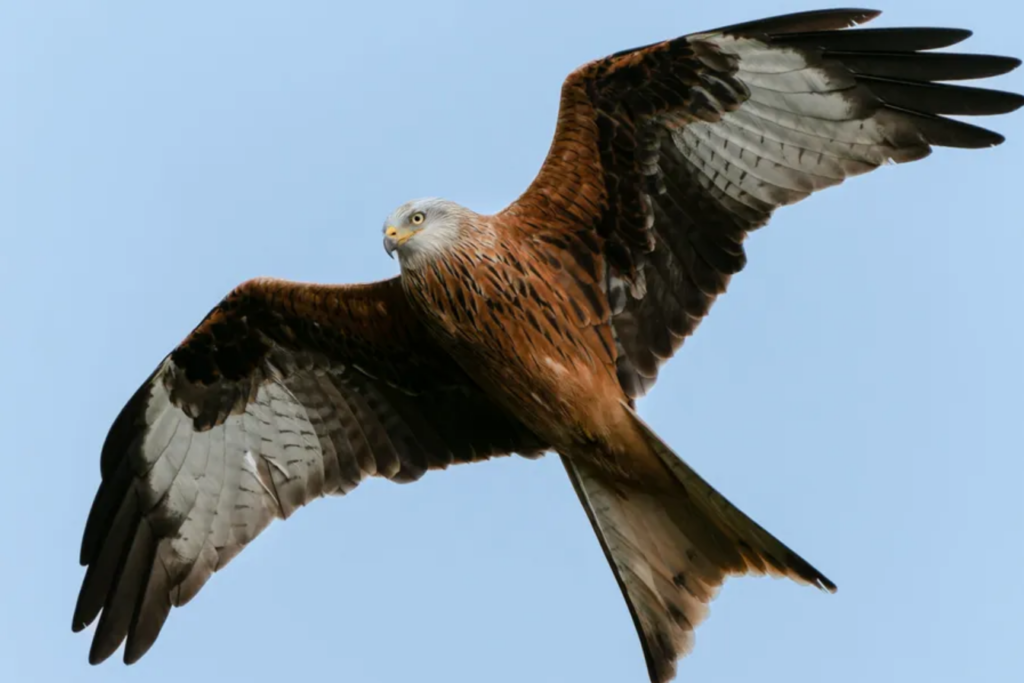
Conservation Status: On the Green list under the Birds of Conservation Concern 5. Listed as least concern under the IUCN Red List.
Distribution: Widespread and common throughout the UK. Estimated 4,600 breeding pairs.
Identification: Red Kites are large birds with a wingspan of up to 2m. Easily identified by their angled red wings, reddish-brown streaky body and a long, forked tail. These birds have a distinctive white patch underneath their black-tipped wings. Adults have a grey head and a yellow beak with a grey-black hook.
Best places to spot: Red Kites can be seen year-round and are active during the day. They can be found in woodland, open countryside, farmland and increasingly in suburban areas and towns. The Chilterns, central Scotland and southern England are great places to spot Red Kites in the UK, although the species is commonplace and can be found across the country.
Sparrowhawk (Accipiter nisus)
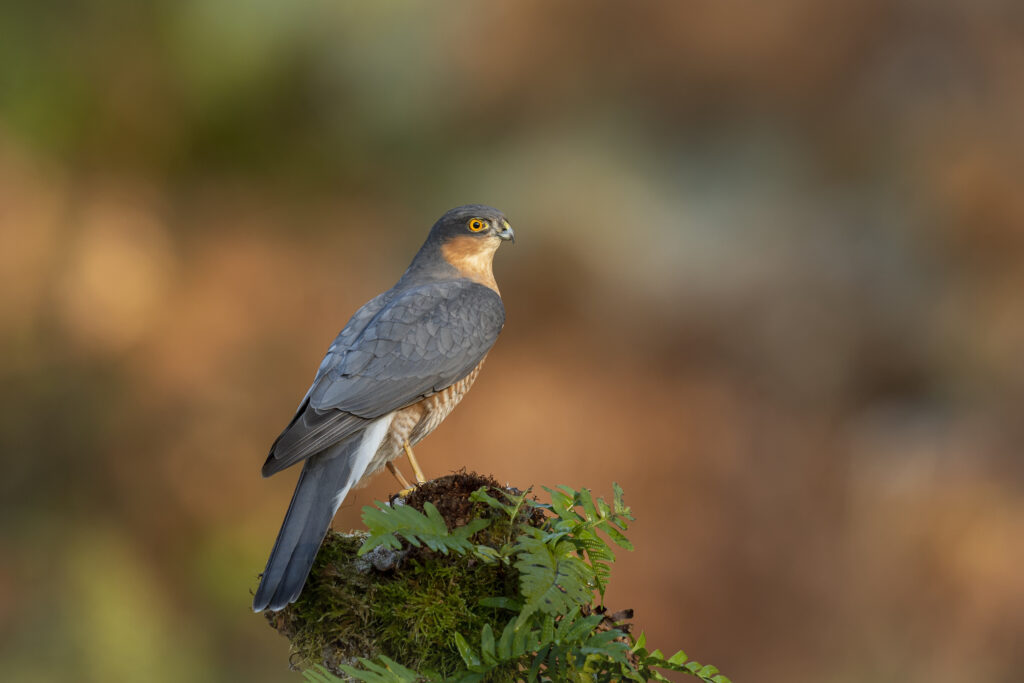
Conservation Status: On the Amber list under the Birds of Conservation Concern 5.
Distribution: Widespread throughout the UK except for the Scottish Highlands and offshore islands. Around 31,000 breeding pairs.
Identification: A small bird of prey with a wingspan of around 60cm, the Sparrowhawk is around the size of a blackbird (although females can be as large as a Feral Pigeon) and weighs up to 300g. Males have a bluish-grey back and cap with white and orange barred underparts. Females are browner in colouration and have brown/grey barring on their underside. The species have broad, rounded wings and bright yellow/orange eyes. The chin and cheeks of both males and females are a reddish orange.
Best places to spot: Sparrowhawks can be found year-round in grassland, woodland, heath and moorland, farmland and suburban areas. Good places to spot Sparrowhawks are: Bowers Marsh, Basildon; Blean Woods, Canterbury and Wolves Wood, Ipswich. The Sparrowhawk is also a good species for garden watchers – often feeding on finches, tits and sparrows, you may be fortunate enough to see one in your own garden.
Peregrine Falcon (Falco peregrinus)
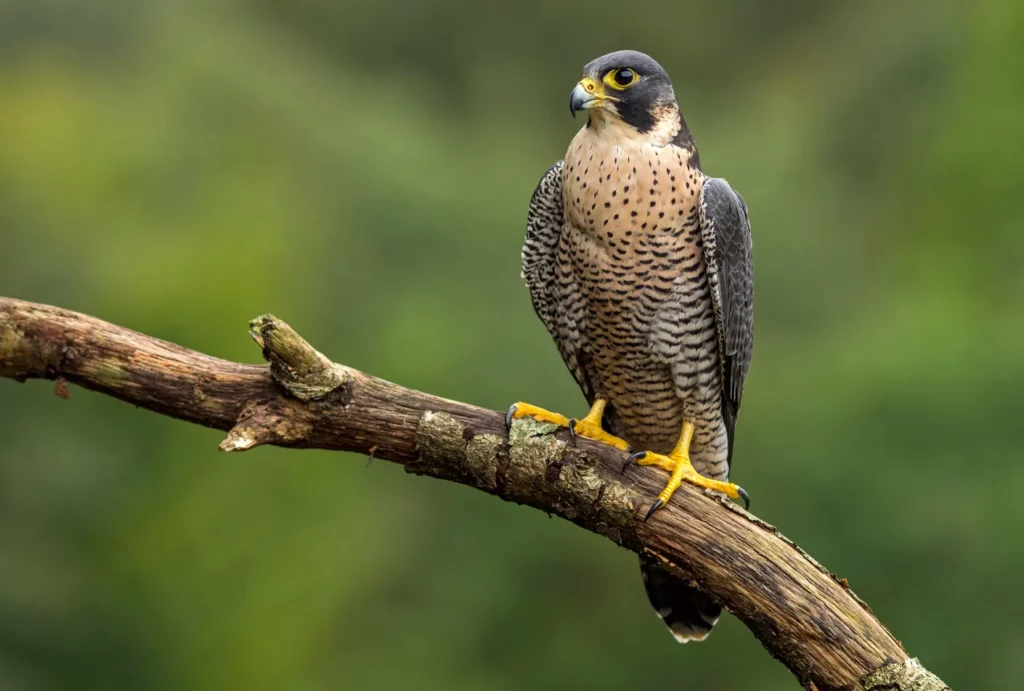
Conservation Status: On the green list under Birds of Conservation Concern 5. Protected under the Wildlife and Countryside Act 1981.
Distribution: Nesting occurs in the north and south-west of England, also in Wales and Scotland on coastal cliffs. There are around 1,750 breeding pairs in the UK.
Identification: The Peregrine Falcon has a large wingspan measuring up to 1.2m and a muscular, heavy-set profile. From above, this bird appears a dark slate-grey with pointed wings and a shorter tail. From below, it appears white with thin, dark stripes across the chest and belly. This species also has a white throat and cheek with a black mask and moustache.
Best places to spot: Peregrine Falcons can be found nesting along coastal cliffs and rocky coastlines. They may also be found in urban areas as their range expands and have famously been found at the top of Derby Cathedral. Great places to spot Peregrine Falcons include Ramsey Island, Pembrokeshire; Saltholme Nature Reserve, Cleveland and Rainham Marshes Nature Reserve, Essex.
Osprey (Pandion haliaetus)
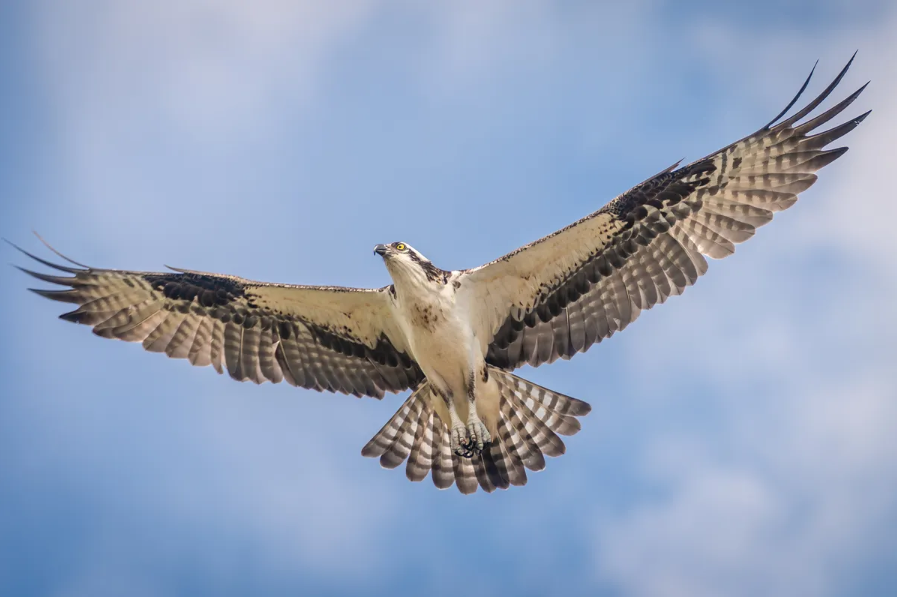
Conservation Status: On the amber list under Birds of Conservation Concern 5. Protected under the Wildlife and Countryside Act 1981.
Distribution: Osprey can be seen from March to September before they migrate to west Africa for the winter. Osprey breed in Scotland, Wales, Cumbria and the east Midlands. Breeding populations are estimated to be between 200–250 pairs.
Identification: Ospreys are large birds with a wingspan of up to 1.7m. The species have brown and white plumage – a dark brown upper contrasting with a white chest, underside and head. The wings are long, barred and appear angled during flight. A ‘necklace’ of slightly darker, mottled colouration may be present, and is more visible in females.
Best places to spot: Osprey have a fish-based diet so are best spotted in freshwater and wetland habitats. Loch Ruthven, Lock Lomond and Loch of Kinnordy are reported to be good locations for Osprey spotting.
Common Buzzard (Buteo buteo)
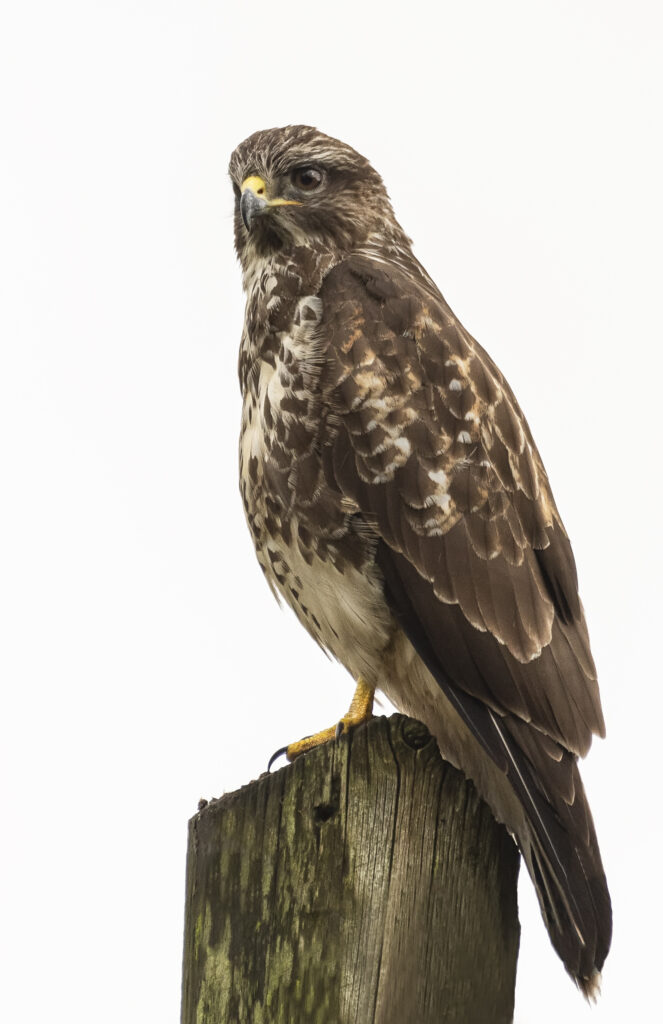
Conservation Status: On the green list under Birds of Conservation Concern 5.
Distribution: The UK’s most common bird of prey, the Common Buzzard can be seen year-round almost everywhere in the UK. The population has an estimated 63,000 breeding pairs.
Identification: A large bird with broad, rounded wings, the Common Buzzard has a wingspan of up to 1.2m. In flight, their wings have a distinctive ‘V’ shape with dark coloured wingtips. Their plumage can vary from shades of dark brown to paler hues, and individuals often have a ‘necklace’ of colour beneath the breast. Their underside is white, some more so than others, and their tail feathers have light brown barring. Their beak is sharp and yellow in colour with a dark brown/black hook.
Best places to spot: Buzzards can be found in farmland, grassland, woodlands and urban areas with green spaces. West Sedgemoor Nature Reserve, Taunton; Fairy Glen, Isle of Skye and Labrador Bay, Torquay are reported to be good places to spot these birds.
Kestrel (Falco tinnunculus)
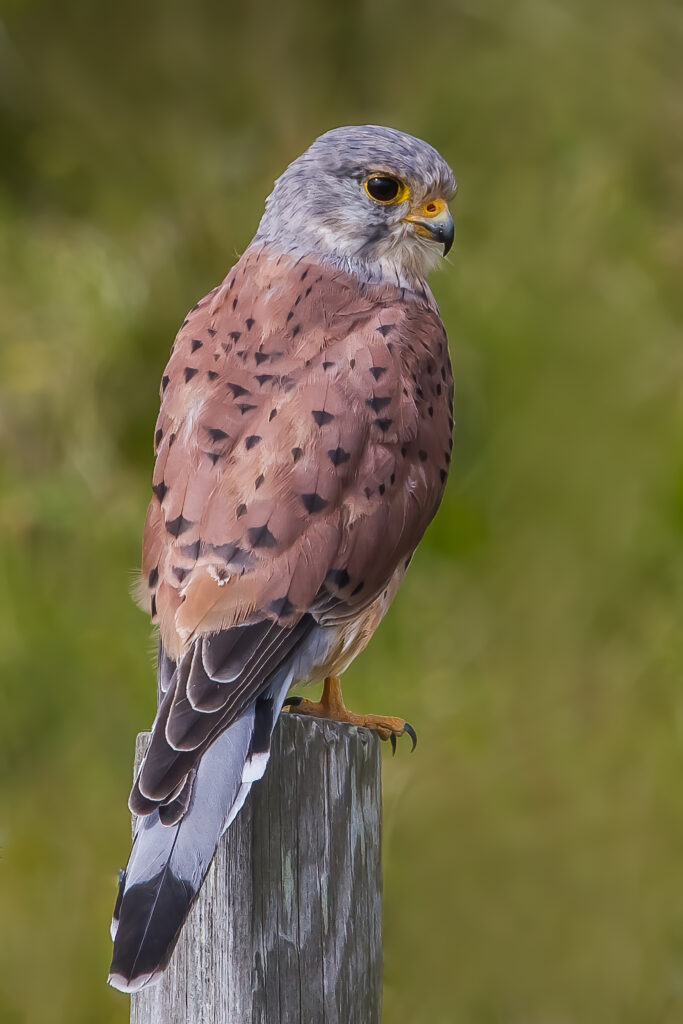
Conservation Status: On the amber list under Birds of Conservation Concern 5. Populations are declining.
Distribution: This species is widespread and can be found year-round across the UK, although absent from north-west Scotland, central Wales and Shetland. There are an estimated 46,000 breeding pairs.
Identification: Slightly larger than a Feral Pigeon, Kestrels have a wingspan up to 80cm. This species is often seen hovering mid-air, and has distinctively pointed wings. The head and tail of male Kestrels is grey, with a black band at the bottom of the tail feathers. Their backs are gingery-brown with a black-speckled cream underside. Females have a more uniform colouration, with a lighter brown plumage and dark bands on the wings and tail. The chest and underside have a lighter, almost-cream plumage with brown spots. The species have a short, yellow/grey beak with a sharp hook.
Best places to spot: Kestrels can be found on open grassland and farmland, wetlands and urban areas. This species is often observed by roadside hedges and may be seen perching on fences or lampposts.
Goshawk (Accipiter gentilis)

Conservation Status: On the green list under Birds of Conservation Concern 5. Protected under the Wildlife and Countryside Act 1981.
Distribution: Found dispersed across the UK in localised populations. Strongholds are present in south and east Scotland, northern England and Wales. There are an estimated 620 breeding pairs.
Identification: This species has a wingspan of up to 120cm and is around the size of a Buzzard. Goshawks have broad wings which appear grey on top. Females have a slate-grey upper and males have a blue-grey upper, both with white, barred underparts. The species has long, thick legs and a rounded tail. Goshawks also have a distinctive white line above their eyes.
Best places to spot: This species can be seen year-round in wetlands, farmland and coniferous woodland. Goshawks are commonly seen in late winter and spring during aerial displays over their breeding grounds. Sites of particular interest are Kielder Forest, New Forest and the Forest of Dean.
Merlin (Falco columbarius)
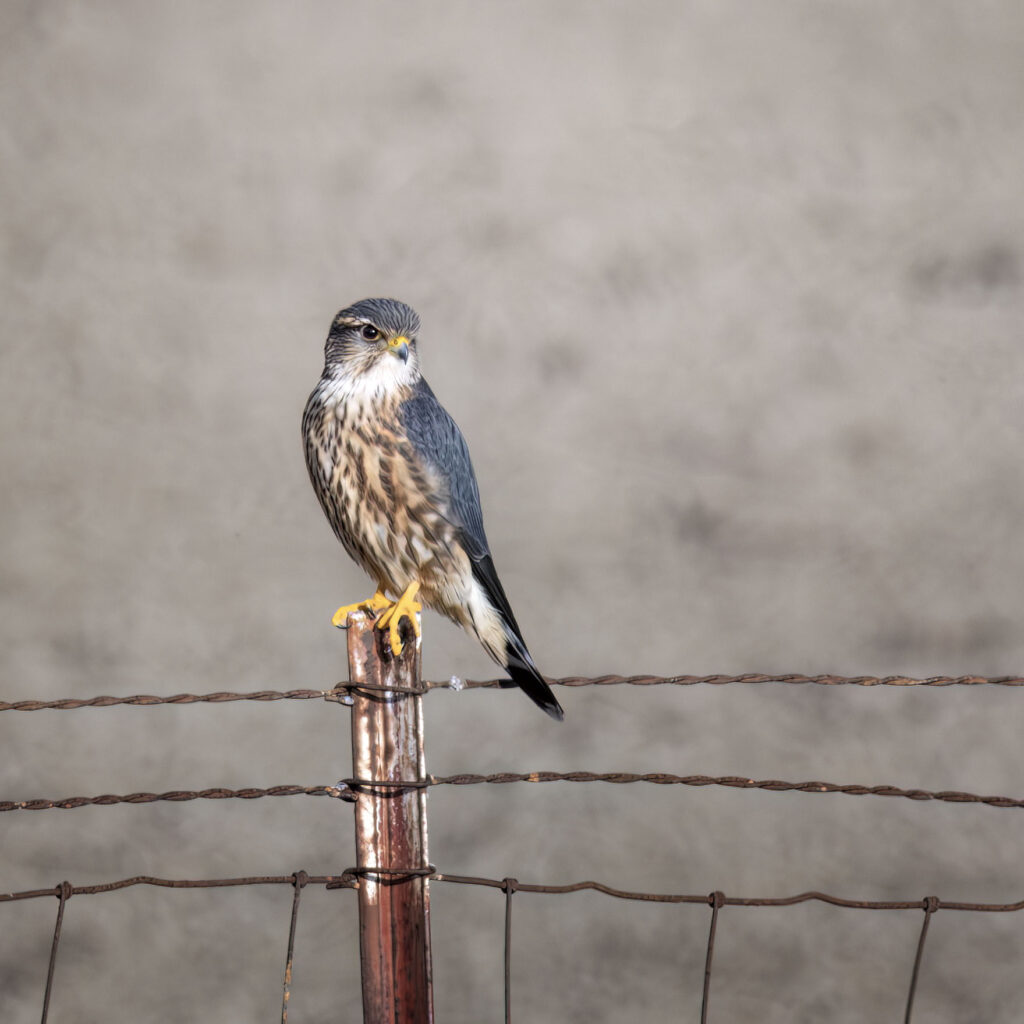
Conservation Status: On the red list under the Birds of Conservation Concern 5. Protected under the Wildlife and Countryside Act 1981.
Distribution: Widespread across the UK. Merlin are seen nesting in north and south-west England, Wales and Scotland. Up to 1,500 breeding pairs are estimated in the UK.
Identification: The UK’s smallest bird of prey, the Merlin is around the size of a Blackbird (Turdus merula). This species is often seen low to the ground or hovering in breezy areas. Males have blue-grey plumage from above with cream-slightly brown underparts with black streaks. Females also have dark streaking underneath but are instead more brown in colour. The species has broad wings with pointed tips (wingspan up to 60cm) and a square, blunt tail. As with other raptors, they have yellow legs and a grey tipped beak.
Best places to spot: This species can be seen year-round in moorland, coastal marshes and farmland where they nest in heather. Orkney, Loch Sunart and Dee Estuary are reported to be excellent places to spot Merlin.
Tawny Owl (Strix aluco)
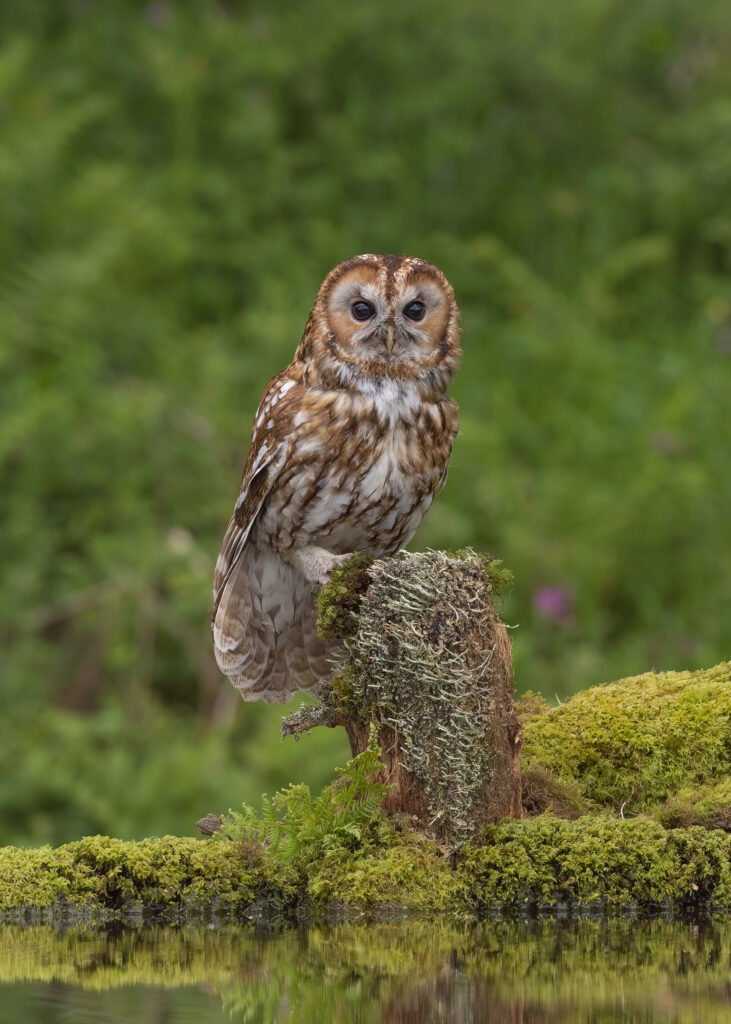
Conservation Status: On the amber list under Birds of Conservation Concern 5.
Distribution: Widespread in the UK, but absent in Northern Ireland and the Isle of Man. An estimated 50,000 breeding pairs in the UK.
Identification: Tawny Owls are the largest common owl in the UK and have a wingspan up to 100cm. They appear a mottled reddish-brown with a paler underside. Their large, round head has a dark ring around its border, and they have characteristically large dark eyes. The species has an olive-yellow hooked beak
Best places to Spot: Tawny Owls can be spotted year-round in broadleaved woodland, farmland and urban green spaces.
Barn Owl (Tyto alba)
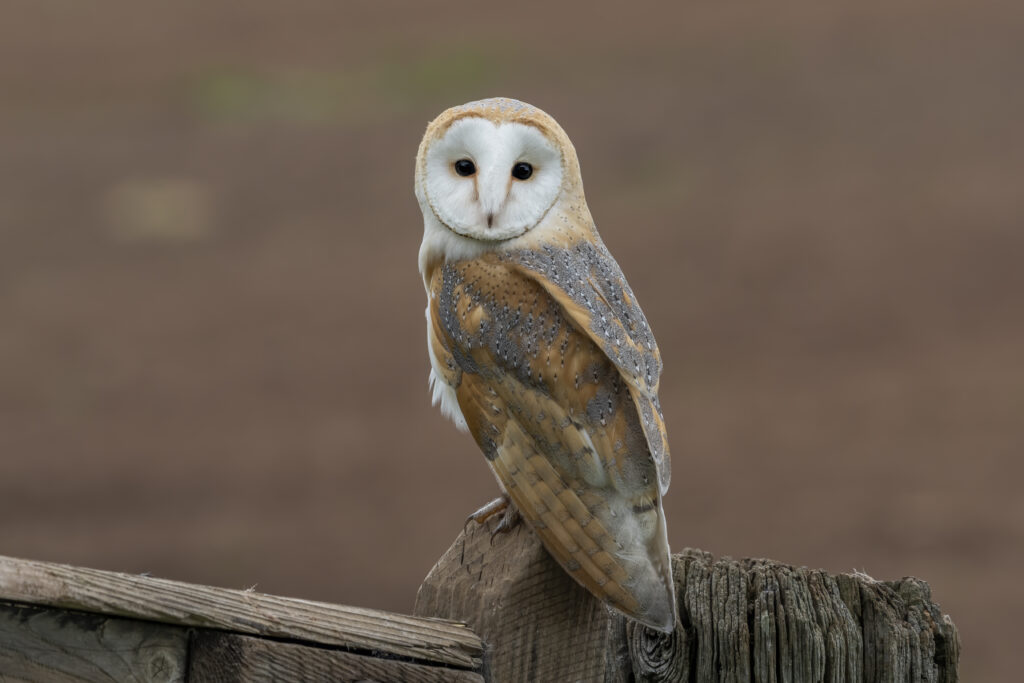
Conservation Status: On the green list under Birds of Conservation Concern 5. Protected under the Wildlife and Countryside Act 1981.
Distribution: Widespread across the UK but absent from the Scottish Highlands. An estimated 4,000 breeding pairs.
Identification: Barn Owls are best known for their distinctive heart-shaped face and snowy white feathers. Their back and wings are mottled grey and beige, with a pure white underside. They have a white face with large black eyes and a short, curved beak.
Best places to spot: Barn Owls can be seen year-round at dawn and dusk. The species may be seen in farmland, grassland and wetland. Strumpshaw Fen, Norfolk; Middleton Lakes, Staffordshire and Bempton Cliffs, East Riding of Yorkshire are reported to be good places to spot Barn Owls in the UK.






